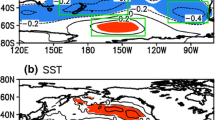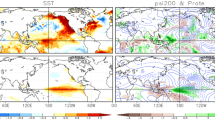Abstract
The Victoria mode (VM), as a basin-scale sea surface temperature (SST) pattern over the North Pacific, is suggested to facilitate subsequent development of El Niño–Southern Oscillation (ENSO) through both the seasonal footprinting mechanism (SFM) and the trade wind charging (TWC) mechanism. The present study aims at investigating the distinct roles and relative contributions to ENSO of the SFM and the TWC mechanism associated with the VM using atmospheric and oceanic reanalysis data as well as modeling simulations. Our results reveal that the positive SST anomalies (SSTAs) over the subtropical northeast Pacific (SNP) related to the VM effectively trigger the initiation of ENSO via the SFM, which emphasizes an air–sea surface thermodynamic-coupling process. In contrast, the negative SSTAs over the western North Pacific (WNP) associated with the VM primarily induce ENSO via a thermocline–SST feedback process, known as the TWC mechanism. Further analysis indicates that the SFM related to the VM may play a relatively independent role in affecting ENSO and is more closely linked to ENSO than is the TWC mechanism related to the VM, which is shown to be reasonably reproduced by the Community Earth System Model. Additionally, the SFM associated with the positive (negative) SNP SSTAs may induce fewer El Niño events (more La Niña events) than the TWC mechanism related to the positive (negative) WNP SSTAs. Our findings suggest that the SFM and the TWC mechanism associated with the VM both contribute to enhanced predictive skill for ENSO.













Similar content being viewed by others
Availability of data and material
The Hadley Centre Global Sea Ice and Sea Surface Temperature data set are downloaded online (from https://www.metoffice.gov.uk/hadobs/hadisst/data/download.html). The National Centers for Environmental Prediction–National Center for Atmospheric Research Reanalysis data (Version I) are from the ESRL website (https://psl.noaa.gov/data/gridded/data.ncep.reanalysis2.pressure.html). The output of the Community Earth System Model Large Ensemble Community Project is available at https://www.cesm.ucar.edu/projects/community-projects/LENS/data-sets.html.
References
Alexander MA, Bladé I, Newman M, Lanzante JR, Lau N-C, Scott JD (2002) The atmospheric bridge: the influence of ENSO teleconnections on air-sea interaction over the global oceans. J Clim 15:2205–2231
Anderson BT (2003) Tropical Pacific sea-surface temperatures and preceding sea level pressure anomalies in the subtropical North Pacific. J Geophys Res-Atmos 108:4732
Anderson BT (2004) Investigation of a large-scale mode of ocean-atmosphere variability and its relation to tropical pacific sea surface temperature anomalies. J Clim 17:4089–4098
Anderson BT, Maloney E (2006) Interannual Tropical Pacific Sea Surface Temperatures and Their Relation to Preceding Sea Level Pressures in the NCAR CCSM2. J Clim 19:998–1012
Anderson BT, Furtado JC, Cobb KM, Di Lorenzo E (2013a) Extratropical forcing of El Niño-Southern Oscillation asymmetry. Geophys Res Lett 40:4916–4921
Anderson BT, Perez RC, Karspeck A (2013b) Triggering of El Niño onset through trade wind–induced charging of the equatorial Pacific. Geophys Res Lett 40:1212–1216
Ashok K, Behera SK, Rao SA, Weng H, Yamagata T (2007) El Niño Modoki and its possible teleconnection. J Geophys Res Oceans 112:C11007
Barnett TP, Pierce DW, Latif M, Dommenget D, Saravanan R (1999) Interdecadal interactions between the tropics and midlatitudes in the Pacific basin. Geophys Res Lett 26:615–618
Bond NA, Overland JE, Spillane M, Stabeno P (2003) Recent shifts in the state of the North Pacific. Geophys Res Lett 30:2183
Bretherton CS, Widmann M, Dymnikov VP, Wallace JM, Bladé I (1999) The effective number of spatial degrees of freedom of a time-varying field. J Climate 12:1990–2009
Chakravorty S, Perez RC, Anderson BT, Larson SM, Giese BS, Pivotti V (2021) Ocean dynamics are key to extratropical forcing of El Niño. J Climate (published online ahead of print 2021). https://journals.ametsoc.org/view/journals/clim/aop/JCLI-D-20-0933.1/JCLI-D-20-0933.1.xml
Chang P, Zhang L, Saravanan R, Vimont DJ, Chiang JCH, Ji L, Seidel H, Tippett MK (2007) Pacific meridional mode and El Niño—Southern Oscillation. Geophys Res Lett 34:L16608
Cheng L, Trenberth KE, Fasullo J, Boyer T, Abraham J, Zhu J (2017) Improved estimates of ocean heat content from 1960 to 2015. Sci Adv 3:e1601545
Chiang JCH, Vimont DJ (2004) Analogous pacific and atlantic meridional modes of tropical atmosphere-ocean variability. J Clim 17:4143–4158
Clement AC, di Nezio PN, Deser C (2010) Rethinking the Ocean's Role in the Southern Oscillation. GC44A-03
Ding R, Li J, Tseng Y-H, Ruan C (2015a) Influence of the North Pacific Victoria mode on the Pacific ITCZ summer precipitation. J Geophys Res-Atmos 120:964–979
Ding R, Li J, Tseng Y-H, Sun C, Guo Y (2015b) The Victoria mode in the North Pacific linking extratropical sea level pressure variations to ENSO. J Geophys Res-Atmos 120:27–45
Ding R, Li J, Tseng Y-H, Li L, Sun C, Xie F (2018) Influences of the North Pacific Victoria Mode on the South China Sea Summer Monsoon. Atmosphere 9:229
Dou J, Wu Z, Zhou Y (2017) Potential impact of the May Southern Hemisphere annular mode on the Indian summer monsoon rainfall. Clim Dyn 49:1257–1269
Grimm AM, Tedeschi RG (2009) ENSO and extreme rainfall events in South America. J Clim 22(1589):1609
Gu D-F, Philander SGH (1997) Interdecadal climate fluctuations that depend on exchanges between the tropical and extratropics. Science 275:805–807
Hendon HH, Liebmann B, Glick JD (1998) Oceanic kelvin waves and the Madden-Julian oscillation. J Atmos Sci 55:88
Kalnay E, Kanamitsu M, Kistler R, Collins W, Deaven D, Gandin L, Iredell M, Saha S, White G, Woollen J, Zhu Y, Chelliah M, Ebisuzaki W, Higgins W, Janowiak J, Mo KC, Ropelewski C, Wang J, Leetmaa A, Reynolds R, Jenne R, Joseph D (1996) The NCEP/NCAR 40-year reanalysis project. Bull Am Meteorol Soc 77:437–472
Kao H-Y, Yu J-Y (2009) Contrasting Eastern-Pacific and Central-Pacific types of ENSO. J Clim 22:615–632
Kay JE, Deser C, Phillips A, Mai A, Hannay C, Strand G, Arblaster JM, Bates SC, Danabasoglu G, Edwards J, Holland M, Kushner P, Lamarque J-F, Lawrence D, Lindsay K, Middleton A, Munoz E, Neale R, Oleson K, Polvani L, Vertenstein M (2015) The Community Earth System Model (CESM) large ensemble project: a community resource for studying climate change in the presence of internal climate variability. Bull Am Meteorol Soc 96:1333
Kessler WS, McPhaden MJ, Weickmann KM (1995) Forcing of intraseasonal Kelvin waves in the equatorial Pacific. J Geophys Res 100:10613
Kleeman R, McCreary JP, Klinger BA (1999) A mechanism for generating ENSO decadal variability. Geophys Res Lett 26:1743–1746
Kug J-S, Jin F-F, An S-I (2009) Two types of El Niño events: cold tongue El Niño and warm Pool El Niño. J Climate 22:1499–1515
Kug J-S, Choi J, An S-I, Jin F-F, Wittenberg AT (2010) Warm pool and cold tongue El Ni?o events as simulated by the GFDL 2.1 coupled GCM. J Clim 23:1226–1239
Lin C-Y, Yu J-Y, Hsu H-H (2015) CMIP5 model simulations of the Pacific meridional mode and its connection to the two types of ENSO. Int J Climatol 35:2352–2358
Linkin ME, Nigam S (2008) The North Pacific oscillation west pacific teleconnection pattern: mature-phase structure and winter impacts. J Clim 21:1979
Liu Z, Xie S (1994) Equatorward propagation of coupled air-sea disturbances with application to the annual cycle of the Eastern Tropical Pacific. J Atmos Sci 51:3807
Liu Z, Wu L, Gallimore R, Jacob G (2002) Search for the origins of Pacific decadal climate variability. Geophys Res Lett 29:1404
Martinez-Villalobos C, Vimont DJ (2017) An Analytical Framework for Understanding Tropical Meridional Modes. J Climate 30:3303
McCreary JP, Lu P (1994) Interaction between the subtropical and equatorial ocean circulations: the subtropical cell. J Phys Oceanogr 24:466–497
Paek H, Yu J-Y, Qian C (2017) Why were the 2015/2016 and 1997/1998 extreme El Niños different? Geophys Res Lett 44:1848–1856
Rayner NA, Parker DE, Horton EB, Folland CK, Alexander LV, Rowell DP, Kent EC, Kaplan A (2003) Global analyses of sea surface temperature, sea ice, and night marine air temperature since the late nineteenth century. J Geophys Res-Atmos 108
Rogers JC (1981) The North Pacific oscillation. J Climatol 1:39–57
Santoso A, McPhaden MJ, Cai W (2017) The defining characteristics of ENSO extremes and the strong 2015/2016 El Niño. Rev Geophys 55:1079–1129
Santoso A, Hendon H, Watkins A, Power S, Dommenget D, England MH, Frankcombe L, Holbrook NJ, Holmes R, Hope P, Lim E-P, Luo J-J, McGregor S, Neske S, Nguyen H, Pepler A, Rashid H, Gupta AS, Taschetto AS, Wang G, Abellán E, Sullivan A, Huguenin MF, Gamble F, Delage F (2019) Dynamics and predictability of El Niño-Southern oscillation: an australian perspective on progress and challenges. Bull Am Meteorol Soc 100:403
Schubert SD, Chang Y, Suarez MJ, Pegion PJ (2008) ENSO and wintertime extreme precipitation events over the contiguous United States. J Climate 21:22–39
Thomas EE, Vimont DJ (2016) Modeling the mechanisms of linear and nonlinear ENSO responses to the Pacific meridional mode. J Climate 29:8745–8761
Vimont D (2010) Transient growth of thermodynamically coupled variations in the tropics under an equatorially symmetric mean state. J Clim 23:5771
Vimont DJ, Battisti DS, Hirst AC (2001) Footprinting: a seasonal connection between the tropics and mid-latitudes. Geophys Res Lett 28:3923–3926
Vimont DJ, Battisti DS, Hirst AC (2003a) The seasonal footprinting mechanism in the CSIRO general circulation models. J Clim 16:2653–2667
Vimont DJ, Wallace JM, Battisti DS (2003b) The seasonal footprinting mechanism in the Pacific: implications for ENSO. J Clim 16:2668–2675
Walker GT, Bliss EW (1932) World weather V. Mem r Meteorol Soc 4:53–84
Wang B, Wu R, Fu X (2000) Pacific-East Asian teleconnection: how does ENSO affect East Asian Climate? J Clim 13:1517–1536
Wang S-Y, L'Heureux M, Chia H-H (2012) ENSO prediction one year in advance using western North Pacific sea surface temperatures. Geophys Res Lett 39:L05702
Wu Z, Zhang P (2015) Interdecadal variability of the mega-ENSO–NAO synchronization in winter. Clim Dyn 45:1117–1128
Wyrtki K (1975) El Niño—the dynamic response of the equatorial Pacific Ocean to atmospheric forcing. J Phys Oceanogr 5:572
Xie S-P, Philander SGH (1994) A coupled ocean-atmosphere model of relevance to the ITCZ in the eastern Pacific. Tellus A 46:340–350
You Y, Furtado JC (2018) The South Pacific meridional mode and its role in tropical pacific climate variability. J Clim 31:10141–10163
Yu J-Y (2011) Reversed spatial asymmetries between El Niño and La Niña and their linkage to decadal ENSO modulation in CMIP3 models. J Clim 24:5423–5434
Yu J-Y, Kim ST (2010) Relationships between extratropical sea level pressure variations and the Central Pacific and Eastern Pacific types of ENSO. J Clim 24:708–720
Yu B, Lin H, Wu Z, Merryfield WJ (2018) The Asian-bering-North American teleconnection: seasonality, maintenance, and climate impact on North America. Clim Dyn 50:2023–2038
Zhang R-H, Levitus S (1997) Structure and cycle of decadal variability of upper ocean temperature in the North Pacific. J Clim 10:710–727
Zhang R-H, Rothstein LM, Busalacchi AJ (1998) Origin of upper-ocean warming and El Nino change on decadal time scales in the Tropical Pacific Ocean. Nature 391:879–883
Zhang P, Wu Z, Chen H (2017) Interdecadal variability of the ENSO-North Pacific atmospheric circulation in winter. Atmos Ocean 55(2):110–120
Zhang XC, Zhong S, Wu Z, Li Y (2018) Seasonal prediction of the typhoon genesis frequency over the Western North Pacific with a Poisson regression model. Clim Dyn 51(11):4585–4600
Zhang P, Wang B, Wu Z (2019) Weak El Niño and Winter Climate in the mid-high latitude Eurasia. J Clim 32:402–421
Funding
This work was jointly supported by the National Natural Science Foundation of China (41790474, 41975070).
Author information
Authors and Affiliations
Corresponding author
Ethics declarations
Conflicts of interest/Competing interests
The authors declare no conflicts of interest/competing interests.
Code availability
The software application applied in the paper is the NCAR Command Language.
Ethics approval
Not applicable.
Consent to participate
The authors consent to participate.
Consent for publication
The authors consent for publication.
Additional information
Publisher's Note
Springer Nature remains neutral with regard to jurisdictional claims in published maps and institutional affiliations.
Rights and permissions
About this article
Cite this article
Ji, K., Tseng, Y., Ding, R. et al. Relative contributions to ENSO of the seasonal footprinting and trade wind charging mechanisms associated with the Victoria mode. Clim Dyn 60, 47–63 (2023). https://doi.org/10.1007/s00382-022-06300-6
Received:
Accepted:
Published:
Issue Date:
DOI: https://doi.org/10.1007/s00382-022-06300-6




